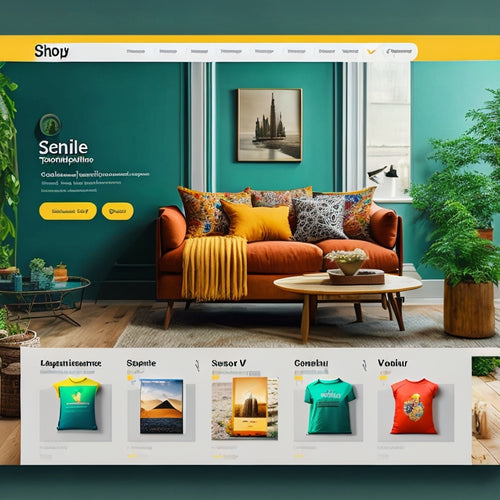
7 Essential Strategies for Ecommerce Online Course Success
Share
To secure ecommerce online course success, you're focusing on the right strategies. First, define and engage with your target audience through market research and customer-centric approaches. Then, create high-quality video content that tells a story and aligns with your brand. Develop a structured curriculum that breaks down topics into manageable chunks and incorporates interactive assessments. Don't forget to optimize for mobile learning, leveraging microlearning and responsive design. Utilize user-generated content to build social proof and foster community engagement. Set realistic goals and track performance metrics to make data-driven decisions. By mastering these essential strategies, you'll be well on your way to creating a compelling and effective ecommerce online course - and that's just the beginning.
Key Takeaways
• Develop targeted online courses by understanding ideal customers through market research and creating customer-centric approaches for engagement.
• Create high-quality, engaging video content with storytelling elements, animations, and graphic design aligned with branding.
• Design a structured learning path with logical modules, interactive assessments, and clear learning objectives to enhance the learning experience.
• Optimize courses for mobile learning with responsive design, microlearning, and interactive quizzes to increase engagement and motivation.
• Track key performance metrics, such as completion rates and revenue generated, to make data-driven decisions and optimize courses for success.
Define Your Target Audience
To successfully launch and sell an ecommerce online course, you must identify and understand who your ideal customers are, as they'll drive the entire development process. You can't create a course that resonates with everyone, so it's essential to narrow down your target audience.
Conduct market research to gather insights about your potential customers' demographics, pain points, and goals. This will help you develop a clear persona, allowing you to tailor your content and marketing strategies to their specific needs.
Create Engaging Video Content
When creating video content for your ecommerce online course, you'll want to focus on crafting high-quality visuals that grab your audience's attention.
You'll also need to script your content for clarity, ensuring your message comes across loud and clear.
High-Quality Visuals Matter
Creating engaging video content for your ecommerce online course requires high-quality visuals that capture learners' attention and convey complex information in an easy-to-digest format.
You'll want to invest in a solid graphic design that aligns with your branding strategy. This will help establish a consistent tone and aesthetic throughout your course, making it more recognizable and memorable to your learners.
When it comes to visual elements, don't skimp on quality. Use high-resolution images, crisp graphics, and engaging animations to break up text-heavy content. This will keep learners engaged and focused on the material.
Additionally, consider using real-life examples, demos, or simulations to illustrate complex concepts. These visual aids will help learners connect abstract ideas to tangible applications, increasing their understanding and retention of the material.
Scripting for Clarity
With your visuals in place, you're ready to craft a script that brings your video content to life and speaks directly to your learners' needs. Your script should tell a story, using visual storytelling to engage your audience and convey complex information in a clear, concise manner.
To do this, focus on the key takeaways you want your learners to absorb, and structure your script around those points. Keep your language simple, avoiding jargon and technical terms that might confuse your audience. Instead, use everyday language that resonates with your learners and encourages audience engagement.
Use anecdotes, examples, and metaphors to make your message more relatable and memorable. Remember, your goal is to educate and inspire, not to impress with your vocabulary. By keeping your script focused, clear, and engaging, you'll create video content that resonates with your learners and drives real results for your ecommerce online course.
Editing for Flow
You'll refine your video content's pacing and tone by editing, trimming, and arranging your clips in a way that flows smoothly and keeps your learners engaged. This is where the magic of editing happens, and you'll transform your raw footage into a polished, engaging course. Effective connections are key to smooth editing, so focus on creating seamless links between clips.
Consistency is also vital, so maintain your tone, pace, and style throughout the course. As you edit, pay attention to your delivery. Aim for engaging, conversational tone that makes learners feel like they're having a one-on-one conversation with you. Cut out any awkward pauses, filler words, or distractions that might disrupt the flow.
Use visual aids, animations, and graphics to enhance the learning experience and keep learners engaged. By focusing on flow, consistency, and engaging delivery, you'll create a course that's not only informative but also enjoyable to watch. Remember, the goal is to educate and entertain, so make sure your editing skills are on point to achieve ecommerce online course success.
Develop a Structured Curriculum
When developing a structured curriculum for your ecommerce online course, you'll want to focus on creating a clear and logical flow of lessons.
You'll need to prioritize the essentials, such as defining your course outline, organizing your modules, and mapping out a learning path that guides your students towards success.
Course Outline Essentials
Developing a structured curriculum for your ecommerce online course begins with identifying the key learning objectives that align with your students' needs and goals. You'll want to create a clear outline that breaks down complex topics into manageable chunks, ensuring your students stay engaged and motivated throughout the course.
To achieve this, consider incorporating elements of course customization, such as allowing students to choose their own learning paths or tailoring the content to specific industries or niches. This won't only boost student engagement but also help you stand out from the competition.
To further enhance the learning experience, incorporate interactive assessments that encourage students to apply what they've learned. This could include quizzes, case studies, or even live projects that simulate real-world ecommerce scenarios. By creating a feedback loop, you can gather valuable insights from your students, refine your course content, and make data-driven decisions to improve the overall learning experience.
Module Organization Tips
Breaking down your ecommerce online course into manageable modules helps students focus on one topic at a time, reducing overwhelm and increasing comprehension. This structured approach enables you to organize your content in a logical and coherent manner, making it easier for students to follow along.
To create effective modules, prioritize time management by allocating specific time slots for each topic. This will help you stay on track and make sure you're covering all essential material.
When curating content for each module, consider student engagement and incorporate interactive activities to keep learners motivated. This can include quizzes, discussion forums, and hands-on exercises that reinforce key concepts. By doing so, you'll create an immersive learning experience that encourages students to participate and apply what they've learned.
Learning Path Blueprint
You'll now create a learning path blueprint, outlining a structured curriculum that guides students through your ecommerce online course, ensuring they absorb and apply each lesson in a logical sequence. This blueprint is essential in helping students stay on track, achieve their goals, and ultimately succeed in the ecommerce space.
To create an effective learning path blueprint, you'll need to conduct a learning style analysis to understand how your students absorb information best. This will help you develop content delivery strategies that cater to their needs, such as video lessons, interactive simulations, or downloadable resources.
Additionally, incorporate interactive assessments to test students' understanding and retention of the material.
To make the learning experience more engaging, consider incorporating gamification techniques, such as points, badges, or leaderboards, to motivate students to complete modules and achieve milestones.
Set Realistic Goals and Objectives
Setting realistic goals and objectives is crucial to ecommerce online course success, as it helps you create a roadmap for your business and stay focused on what needs to be achieved. By setting specific, measurable, and attainable goals, you'll be able to track your progress and make adjustments as needed.
Effective goal setting also helps to boost student motivation, as clear objectives give students a sense of direction and purpose.
When setting goals, consider both short-term and long-term objectives. Break down larger goals into smaller, manageable tasks to help you stay on track. Make sure your goals are aligned with your overall business strategy and are achievable based on your resources and capabilities.
By doing so, you'll be able to create a sense of accomplishment and motivation, driving you to continue working towards your goals.
Optimize for Mobile Learning
With your goals and objectives in place, it's time to think about how your students will access your ecommerce online course, and optimizing for mobile learning is a key aspect of this.
As most students will likely access your course on their mobile devices, you need to guarantee that your content is optimized for a seamless user experience. This means using a responsive design that adapts to different screen sizes and devices.
You should also consider employing microlearning techniques, breaking down complex topics into bite-sized chunks that are easy to digest on a small screen.
Interactive quizzes and engagement strategies can also help to keep students engaged and motivated, even on a mobile device.
Leverage User-Generated Content
By encouraging students to share their own experiences, tips, and success stories, you can tap into a powerful marketing tool that not only builds trust and credibility but also fosters a sense of community around your ecommerce online course.
This user-generated content can be showcased through social media, testimonials, and case studies, providing social proof that your course delivers results. When students see real people achieving success, they're more likely to trust your course and invest in it.
You can also collaborate with influencers who've taken your course to share their own experiences, further amplifying your reach. Additionally, community engagement is key - respond to comments, answer questions, and acknowledge success stories to create a sense of belonging.
This authenticity will set you apart from competitors and make your course more attractive to potential students.
Track and Analyze Performance
How do you know if your ecommerce online course is on track to meet its goals, and what adjustments can you make to optimize its performance? To answer these questions, you need to track and analyze your course's performance metrics. This includes monitoring metrics such as course completion rates, audience engagement, and revenue generated. By keeping a close eye on these metrics, you'll be able to identify areas that need improvement and make data-driven decisions to optimize your course.
Data analysis is key to course improvement. It allows you to pinpoint what's working and what's not, and make targeted changes to enhance the learning experience. For instance, if you notice that students are struggling with a particular module, you can revise the content to make it more engaging and effective.
Frequently Asked Questions
How Do I Protect My Course Content From Piracy and Theft?
Did you know 67% of online course creators experience piracy? You can safeguard your content by implementing copyright protection and encryption, plus digital rights management tools with watermarking to track unauthorized access.
Can I Use Existing Branded Content in My Online Course?
When repurposing existing branded content for your online course, you'll need to navigate copyright considerations and content licensing agreements. Make sure you're aware of fair use limitations and branding opportunities to avoid legal issues and maintain your brand's integrity.
Do I Need to Provide Customer Support for My Online Course?
You'll need to provide customer support for your online course, offering multiple communication channels and technical assistance to resolve issues, ensuring a seamless learner experience and building trust with your customers.
How Do I Handle Refunds and Course Cancellations?
You'll want to clearly outline refund policies and communication plans upfront to avoid disputes. When managing cancellations, prioritize customer satisfaction by being responsive, empathetic, and fair, ensuring a smooth process that maintains your reputation.
Can I Offer My Online Course for Free or at a Discounted Rate?
Like a master chef, you're seasoning your online course with the perfect pricing strategy. You're wondering, can you offer it for free or at a discounted rate? Yes, but weigh the pros and cons of free vs. paid and consider discounted rates to attract new customers.
Related Posts
-
The Power Of Short-Form Video For Driving Ecommerce
Short-form videos have transformed the eCommerce landscape, becoming a vital tool for driving conversions and revenue...
-

Designing Engaging Online Learning for Merchants
To design engaging online learning for merchants, start by identifying their knowledge and skill gaps, then craft spe...
-

Do You Need a SEO App for Shopify
This article examines the necessity of utilizing a SEO app for Shopify. By considering the benefits of incorporating...

